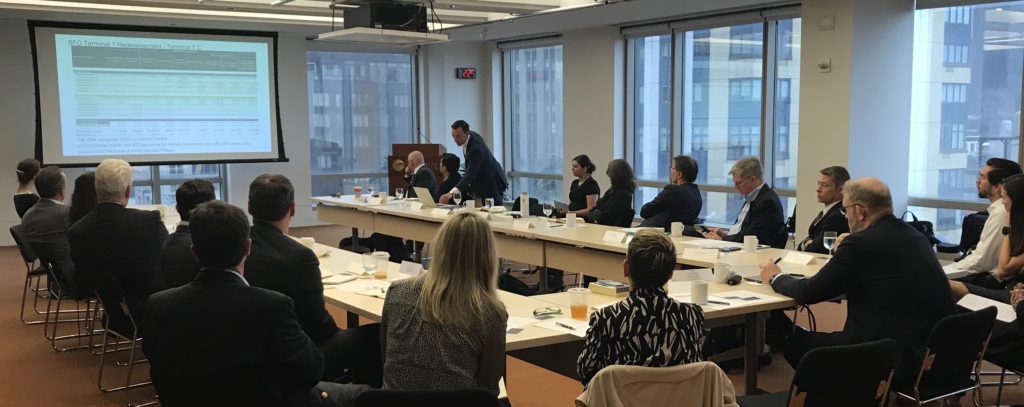The New York City Autocase Advisory Group (AAG) meeting brought together a diverse mix of
professionals across multiple disciplines to discuss sustainability and resilience in both New
York and North America at large.

John Williams, Impact Infrastructure, opened the meeting with a conversation relative to the
evolution of the use of economic analysis to determine the value of “green.” He stressed the use
of objective economic data to determine project value stated as triple bottom line returns on
investment realized by key stakeholder groups (owners, tenants and host community). He
offered examples of how costs and benefits can be exchanged among project stakeholders to
achieve each of their financial, economic, social and environmental objectives.
Eric Bill, Katelyn Lawson and Shane Minckley, Autocase, provided an overview of how New
York City is taking large steps towards more energy efficient infrastructure, highlighted by the
recently passed legislation termed the Climate Mobilization Act. Perhaps the cornerstone of this
package of bills is a mandate towards carbon emission by buildings; buildings over 25,000 feet
are required to cut emissions by 40% by 2030 and by 80% by 2050. These retrofits are
estimated to cost around $4.4 billion, a large price tag and massive set of retrofit projects, where
optimizing decision making and design will be crucial for all stakeholders involved. The AAG
discussed how these regulations will impact buildings across NYC, and how to potentially “get
ahead” of these energy regulations to focus on overarching goals relative to climate change and
reduction of carbon emissions. Merits of identifying tactics including materials selection, carbon
sequestration, water related and other GHG reduction techniques that deliver greater returns on
investment in anticipation of future regulatory waves or as supplementary to current building
retrofit requirements were discussed. The ability to document economic returns within
comprehensive business cases is essential to moving conversations aimed at shaping future
policy.
Janice Barnes from Waggonner & Ball, posed a fundamental question; how might we bring
more value to our individual projects? Through her work on a variety of projects in New Orleans,
Louisiana, Janice has successfully implemented strategies on individual projects which helped
to reduce flood risk, increase economic opportunity, and revitalize neighborhoods. However,
she also questions if we are missing the chance to add more value to the communities that our
projects are in by not taking a larger perspective on the overall system. Through district scale
consideration of multiple project opportunities, a more holistic view on human and natural
processes can help to optimize both project specifics and project prioritization, resulting in better
outcomes for all parties involved. The sum of all projects could actually be greater to the
community, than the individual contributions.
Stephen Brown and Angela Spangler from the International WELL Building Institute gave a
compelling presentation on the need of more prioritization of building impacts on occupant
health and wellness. For commercial, industrial, or office buildings, an overlooked but
exceedingly large portion of yearly costs are employee related. Investments in the well-being of
occupants can provide sizeable, tangible returns through productivity, employee retention, and
talent acquisition on top of individual level benefits such as health and happiness. The health of
people and the health of the planet are linked at scale, and WELL is leading the charge towards
more consideration towards people and their relationships to the spaces they occupy.
The presentations were wrapped up by an engaging investigation of the fundamentals of the
business of buildings by Phil Bernstein, Associate Dean of the Yale School of Architecture. His
excitement over the ability to predict outcomes is matched by his interest in the changes
necessary to actualize the potential of the analytics they produce, and he proposed that a re-
factoring of the risk/return relationship and a shift to outcome-based compensation structures
were the way to make this happen. The current state of the field is dominated by first-cost
thinking, producing buildings based in least cost as opposed to best value. Rethinking the way
that the building design, construction, and operation process is done is a crucial step towards
better building performance across all aspects.
The takeaways from the day were centered around how infrastructure decisions effect more
than just financial numbers – impacting building occupants, communities at-large, and the
environment we live in. Providing higher performing buildings and infrastructure requires more
than just better materials or design, it requires better decision-making processes, and through
refinement of that process, better outcomes will follow.
0 Comments